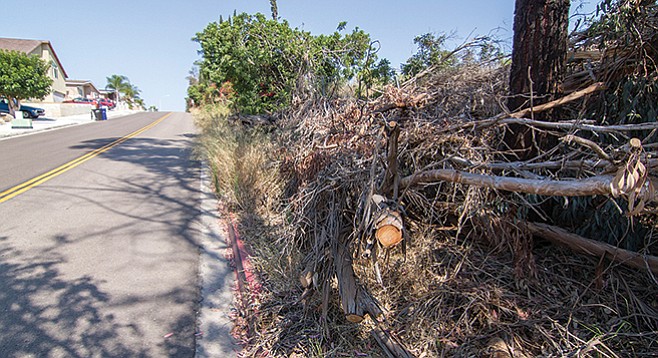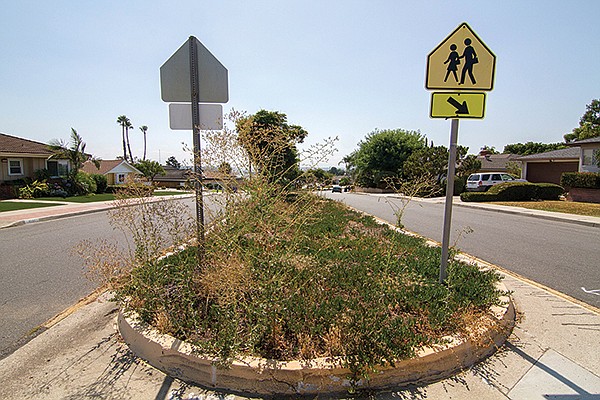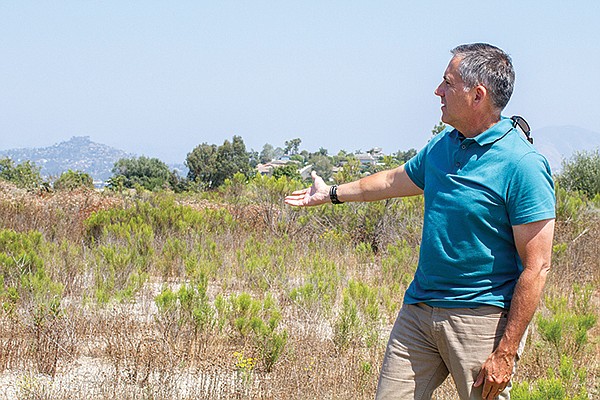 Facebook
Facebook
 X
X
 Instagram
Instagram
 TikTok
TikTok
 Youtube
Youtube

After 15 years of trying, residents of San Diego’s Del Cerro neighborhood may finally have a maintenance assessment district to call their own.

Maintenance assessment districts are mechanisms wherein property owners within a certain area pay extra on monthly property tax bills to fund neighborhood improvements. Supporters of the self-imposed assessments say the districts empower community members by giving them control over what improvements will be made. Opponents, however, say the assessment districts are nothing but taxes passed without a public vote. Critics also say the taxes are a ruse used by the city to help pay for services that they already pay for on property-tax bills.
Since 1969, the City of San Diego has helped create 58 tax districts.
In Del Cerro, a small hillside community of 2400 residents adjacent to San Diego State University where the cost of single-family homes ranges from $740,000 to $1.5 million, members of the Del Cerro Action Council and its off-shoot (The Friends of Del Cerro) have submitted their proposal to the City of San Diego’s Park and Recreation Department. Staffers are currently drafting an engineer’s report, which will serve as the district’s rulebook.

The next step is trying to convince enough residents to pay an extra $150 per year on their property tax bills to improve medians on College Avenue and Del Cerro Boulevard, install new streetlights, increase the maintenance of neighborhood parks, and clean canyons and repair sidewalks.
Del Cerro resident Mark Rawlins’s reason for spearheading the effort to bring an assessment district to Del Cerro is simple: he feels the community looks run-down and the city’s maintenance standard is subpar. “Del Cerro is safe. There’s low crime, but it’s an older community and many of the improvements to medians were done by residents, not the city. The grass at Princess View Park is dying, the playground needs upkeep, and basically things won’t get any nicer unless the community takes matters into their own hands,” Rawlins says during a phone interview.

Rawlins, who moved to Del Cerro in 1994, was skeptical when first approached about creating a new tax district. “I said ‘Heck, no.’ I thought — and still do, really — that the city should be responsible for maintaining and improving our community. But during that time I’ve seen the medians deteriorate, grass at the local parks decay, and my hopes that the city would pay to improve our community fade away. Looking at the city budget, that’s just not going to change. Their standard is concrete and asphalt, not landscaped medians.”
In 2003, Rawlins and other members of the Del Cerro Action Council started their efforts to create a maintenance assessment district. Opposition mounted and later quashed the effort. Much has changed since 2003, says Rawlins, and support has grown. He says the younger families who have recently moved into the neighborhood are more willing to chip in. In 2015, Rawlins and his cohorts renewed their drive to create an assessment district.
Many residents who opposed forming an assessment district in 2003 remain steadfast in their opposition. They say that Del Cerro Action Council members have intimidated and misrepresented the truth to residents in order to create the district.
Joe Ney, who moved to Del Cerro in 1999, says he opposes the district’s creation because, “Maintenance Assessment Districts are nothing more than a tax increase, a ruse used by local governments to bilk money from residents while bypassing state tax laws. Proposition 13 requires governments get two-thirds’ voter approval to raise taxes; assessment districts only require a simple majority. No matter how you sugarcoat it, these are unconstitutional.”
Ney says his opposition has resulted in anonymous crank calls and anonymous threats sent to his house. But he refuses to budge. He believes, if passed, the increased property-tax bills would put a strain on many of the older retirees who live on fixed incomes.
“I know of several people who could conceivably lose their homes. The assumption about Del Cerro is everyone is wealthy. Well, that’s just not true. Many residents are retired and would need to make sacrifices in order to pay the tax, whether that be cancelling cable, their phone, what have you, it doesn’t matter. It shouldn’t happen.
Ney, a retired state investigator, says he and other opponents have already collected 700 signatures from residents who will not vote for the new district.
The debate in Del Cerro is a microcosm of the larger legal issues involving maintenance assessment districts in San Diego.
Over the course of the past decade, residents of communities in Golden Hill, South Park, La Jolla, and a public advocacy group (San Diegans for Open Government) have challenged the districts in court.
In the case of Golden Hill, a judge found the city improperly weighted the district vote in order to make it pass. The residents who sued also prevailed in showing an overall lack of distinction between general benefits the city was responsible for and the special benefits performed by the district. The city was forced to invalidate the maintenance assessment district, pay $300,000 in attorney fees, and issue refunds to property owners — only a small number of residents, however, qualified for reimbursement due to a statute of limitations the city placed on the refund process.
In 2013, San Diegans for Open Government challenged the legality of imposing assessments without a public vote. The trial judge, and later the appellate court, dismissed the lawsuit due to the fact that none of the group’s members lived in a community that paid an assessment.
The challenges continue. In December 2016, former city attorney Mike Aguirre filed a lawsuit on behalf of a group of La Jolla residents calling into question the legality of the community’s maintenance assessment district. In the lawsuit, Aguirre argues that the assessments are being used to pay for general services that the city is already required to perform, meaning residents are paying double for the same services. That case is now making its way through the courts.
According to Del Cerro resident Ney, the city will have another lawsuit on its hands if the Del Cerro maintenance assessment district is formed.
“If council authorizes a vote, I am fully prepared to file a lawsuit,” says Ney. “I strongly believe the city is in collusion to create this district. Why wouldn’t they be? It’s essentially free money. That only gives me more motivation to defeat this.”
According to Cory Briggs, the attorney for San Diegans for Open Government, the lawsuits aren’t likely to end and the city’s attempt at rewriting the law governing the districts falls short of the law.
“These assessments are taxes disguised as fees,” says Briggs. “Taxes require a public vote by flesh-and-blood registered voters, not by property owners. Property-ownership requirements for voting were abolished by the federal Constitution in the 19th Century.”
Adds Briggs, “The city’s process continues to be an illegal tax because it is essentially a neighborhood slush fund with no meaningful accountability or responsiveness to the community when it has concerns about how the city is spending the money, and it allows the city to balance its budget on the backs of desperate communities who see [maintenance assessment districts], despite their legal and administrative problems, as preferable to abject neglect that politicians otherwise allow.”
But for residents such as Rawlins, there is little left for residents to do when trying to improve their neighborhoods above the city’s standard.
“The city has no money, so what are we supposed to do, hold the city’s feet to the fire to spur change? That won’t work,” Rawlins laments. “Del Cerro is a small-peanuts community in San Diego’s eyes. This is a relatively minor investment for residents to ensure a higher standard of service. If we don’t do it, then nobody will. It’s time we take ownership of our community.”


After 15 years of trying, residents of San Diego’s Del Cerro neighborhood may finally have a maintenance assessment district to call their own.

Maintenance assessment districts are mechanisms wherein property owners within a certain area pay extra on monthly property tax bills to fund neighborhood improvements. Supporters of the self-imposed assessments say the districts empower community members by giving them control over what improvements will be made. Opponents, however, say the assessment districts are nothing but taxes passed without a public vote. Critics also say the taxes are a ruse used by the city to help pay for services that they already pay for on property-tax bills.
Since 1969, the City of San Diego has helped create 58 tax districts.
In Del Cerro, a small hillside community of 2400 residents adjacent to San Diego State University where the cost of single-family homes ranges from $740,000 to $1.5 million, members of the Del Cerro Action Council and its off-shoot (The Friends of Del Cerro) have submitted their proposal to the City of San Diego’s Park and Recreation Department. Staffers are currently drafting an engineer’s report, which will serve as the district’s rulebook.

The next step is trying to convince enough residents to pay an extra $150 per year on their property tax bills to improve medians on College Avenue and Del Cerro Boulevard, install new streetlights, increase the maintenance of neighborhood parks, and clean canyons and repair sidewalks.
Del Cerro resident Mark Rawlins’s reason for spearheading the effort to bring an assessment district to Del Cerro is simple: he feels the community looks run-down and the city’s maintenance standard is subpar. “Del Cerro is safe. There’s low crime, but it’s an older community and many of the improvements to medians were done by residents, not the city. The grass at Princess View Park is dying, the playground needs upkeep, and basically things won’t get any nicer unless the community takes matters into their own hands,” Rawlins says during a phone interview.

Rawlins, who moved to Del Cerro in 1994, was skeptical when first approached about creating a new tax district. “I said ‘Heck, no.’ I thought — and still do, really — that the city should be responsible for maintaining and improving our community. But during that time I’ve seen the medians deteriorate, grass at the local parks decay, and my hopes that the city would pay to improve our community fade away. Looking at the city budget, that’s just not going to change. Their standard is concrete and asphalt, not landscaped medians.”
In 2003, Rawlins and other members of the Del Cerro Action Council started their efforts to create a maintenance assessment district. Opposition mounted and later quashed the effort. Much has changed since 2003, says Rawlins, and support has grown. He says the younger families who have recently moved into the neighborhood are more willing to chip in. In 2015, Rawlins and his cohorts renewed their drive to create an assessment district.
Many residents who opposed forming an assessment district in 2003 remain steadfast in their opposition. They say that Del Cerro Action Council members have intimidated and misrepresented the truth to residents in order to create the district.
Joe Ney, who moved to Del Cerro in 1999, says he opposes the district’s creation because, “Maintenance Assessment Districts are nothing more than a tax increase, a ruse used by local governments to bilk money from residents while bypassing state tax laws. Proposition 13 requires governments get two-thirds’ voter approval to raise taxes; assessment districts only require a simple majority. No matter how you sugarcoat it, these are unconstitutional.”
Ney says his opposition has resulted in anonymous crank calls and anonymous threats sent to his house. But he refuses to budge. He believes, if passed, the increased property-tax bills would put a strain on many of the older retirees who live on fixed incomes.
“I know of several people who could conceivably lose their homes. The assumption about Del Cerro is everyone is wealthy. Well, that’s just not true. Many residents are retired and would need to make sacrifices in order to pay the tax, whether that be cancelling cable, their phone, what have you, it doesn’t matter. It shouldn’t happen.
Ney, a retired state investigator, says he and other opponents have already collected 700 signatures from residents who will not vote for the new district.
The debate in Del Cerro is a microcosm of the larger legal issues involving maintenance assessment districts in San Diego.
Over the course of the past decade, residents of communities in Golden Hill, South Park, La Jolla, and a public advocacy group (San Diegans for Open Government) have challenged the districts in court.
In the case of Golden Hill, a judge found the city improperly weighted the district vote in order to make it pass. The residents who sued also prevailed in showing an overall lack of distinction between general benefits the city was responsible for and the special benefits performed by the district. The city was forced to invalidate the maintenance assessment district, pay $300,000 in attorney fees, and issue refunds to property owners — only a small number of residents, however, qualified for reimbursement due to a statute of limitations the city placed on the refund process.
In 2013, San Diegans for Open Government challenged the legality of imposing assessments without a public vote. The trial judge, and later the appellate court, dismissed the lawsuit due to the fact that none of the group’s members lived in a community that paid an assessment.
The challenges continue. In December 2016, former city attorney Mike Aguirre filed a lawsuit on behalf of a group of La Jolla residents calling into question the legality of the community’s maintenance assessment district. In the lawsuit, Aguirre argues that the assessments are being used to pay for general services that the city is already required to perform, meaning residents are paying double for the same services. That case is now making its way through the courts.
According to Del Cerro resident Ney, the city will have another lawsuit on its hands if the Del Cerro maintenance assessment district is formed.
“If council authorizes a vote, I am fully prepared to file a lawsuit,” says Ney. “I strongly believe the city is in collusion to create this district. Why wouldn’t they be? It’s essentially free money. That only gives me more motivation to defeat this.”
According to Cory Briggs, the attorney for San Diegans for Open Government, the lawsuits aren’t likely to end and the city’s attempt at rewriting the law governing the districts falls short of the law.
“These assessments are taxes disguised as fees,” says Briggs. “Taxes require a public vote by flesh-and-blood registered voters, not by property owners. Property-ownership requirements for voting were abolished by the federal Constitution in the 19th Century.”
Adds Briggs, “The city’s process continues to be an illegal tax because it is essentially a neighborhood slush fund with no meaningful accountability or responsiveness to the community when it has concerns about how the city is spending the money, and it allows the city to balance its budget on the backs of desperate communities who see [maintenance assessment districts], despite their legal and administrative problems, as preferable to abject neglect that politicians otherwise allow.”
But for residents such as Rawlins, there is little left for residents to do when trying to improve their neighborhoods above the city’s standard.
“The city has no money, so what are we supposed to do, hold the city’s feet to the fire to spur change? That won’t work,” Rawlins laments. “Del Cerro is a small-peanuts community in San Diego’s eyes. This is a relatively minor investment for residents to ensure a higher standard of service. If we don’t do it, then nobody will. It’s time we take ownership of our community.”
Comments